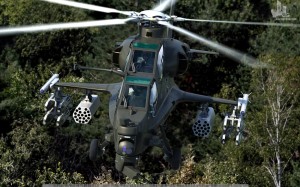
It should be noted that Pakistani elites are considering the partnership with China as a certain guarantee of Pakistan’s security, in a situation when those two states are getting increasingly cautious of their neighbor – India. So the news that in 2014 China entered the ranks of top three arms exporters, while 41% of its military shipments being sent to Pakistan, show the scale of this cooperation.
In 2009 Chendu Aircraft assisted Pakistan Aeronautical Complex in launching the production of light multipurpose fighter JF-17 that was designed in China especially for the needs of the Pakistani Air Force units. In 2015 Pakistani army started getting Z-10 (also known as WZ-10) helicopters that were originally developed in China, which will be put to good use to fight terrorists in Pakistan. It is reported that these helicopters are capable of hitting their targets at a distance up to 2,5 miles away, without entering the zone of enemy fire. It is no surprise that China used the experience and the expertise of the Russian experts from Kamov in the development of this helicopter that is now produced in China by Changhe Aircraft Industries Corporation (CAIC).
Recently the two countries agreed on the shipment of eight brand new diesel-electric Type 41 submarines (known in NATO countries as Yuan-class) to Pakistan. This deal’s worth is nearing the whooping 5 billion dollars and Beijing has already expressed its readiness to provide Islamabad with long-term loans to pay for this contract.
The further development of political, economic and military cooperation between the two countries was ensured by the official visit of the General Secretary of the Communist Party, Xi Jinping that arrived to Pakistan on April 20. Right of the bat China’s leader presented Pakistani elites with a 46 billion dollars investment plan. The better part of the funds provided by Beijing will be allocated in the development of Gwadar port which, according to some analysts, can be considered the beginning of a large-scale Chinese project of stationing naval forces in the Middle East.
A considerable amount of Chinese troops in Gwadar will allow Beijing to secure international trade routes that would ensure that resources for the Chinese industry won’t be blocked from getting to its destination point. At the same time the development of Gwadar – is a part of a large-scale project of creating a Sino-Pakistani economic corridor, which involves the construction of nearly two thousand miles of railways, along with pipelines from the Pakistani port of Gwadar to the Chinese city of Kashgar. Another objective of the Chinese investors is the reconstruction of the Karakoram highway that is stretching from China to Pakistan. This would make a number of Chinese provinces more competitive economically wise, while creating an alternative corridor that would bypass the Strait of Malacca. These projects can jeopardize the key US objective of containing China big time, since Washington won’t be able to contain China along its maritime borders anymore.
In these circumstances in order to leave Pakistan in its zone of influence, the United States agreed to sell Islamabad eight GRC43M patrol boats in late 2014, the total worth of which amounts to 350 million dollars. This deal was signed under the pretext of facilitating Pakistan’s efforts in combating piracy and drug trafficking in the north of the Arabian Peninsula. This January Washington shipped the weapons and ammunition that was used by the troops of Afghan International Security Assistance Force to Pakistan . A couple of weeks ago the US government has approved the delivery of helicopters, missiles and other military equipment to Pakistan the total worth of which amounts to 1 billion dollars. In particular, it is going to sell 15 attack helicopters Bell AH-1Z Viper with all the necessary weapons and equipment to operate them, along with 356 AGM-114R Hellfire II guided missiles. These systems are to be used to carry out anti-terrorist operations in North Waziristan Agency, in the “tribal areas” and other remote and mountainous areas of Pakistan. The deal is expected to be finalized in the next five years, since it involves the participation of the US military forces in the technical and training support of Pakistani units.
The helicopters in question – AH-1Z (also known as Bell 449 SuperCobra) is the latest modification of a well-known family of US combat helicopters, but AH-1 Cobra has been in production for the US Marine Corps exclusively since 2006. Despite the fact that Bell Helicopter has been trying to promote its AH-1Z on the international market, it has failed to get any success with it. Therefore Pakistan will be the first foreign customer that agreed to buy these helicopters. Pakistani army units have been using Bell AH-1 Cobra for a long time, they were provided with 20 AH-1S in 1984-1986 and 32 helicopters AH-1F in 2003-2010.
Thus, Pakistan has become an arena of active struggle for influence between Washington and Beijing, just like the market of contention for US and Chinese arms dealers.
Valery Kulikov, political analyst, exclusively for the online magazine “New Eastern Outlook”.
